Whenever a new comic, film, or TV series is announced, there is always an element of nervous anticipation. Many factors can influence the level of anticipation, and when it comes to remakes, reboots, or adaptations, no matter how hard you try, there will always be those who instantly dislike what has been announced. Luckily, for Mad Cave Studios, fans of Dick Tracy tend towards the positive—largely because there is a lack of new new stories, so any new product is a welcome one. Yes, it is always a gamble, but no matter what you thought of the previous incarnations of the great American detective, whenever anybody works on a title like this, you know they are putting 100% of themselves into it. The one thing that unites people who have worked on Dick Tracy in its near 100 years of existence is that they have a strong passion for the character and the world created by Chester Gould’s.
Gould was committed to producing the best comic strip week after week for decades. Warren Beatty had a concept for a movie version as early as 1975, with his passion for the project keeping him obsessed with it into the 1990s. And the new creators working on the Mad Cave comic all have exciting things to say about their work. In the press release for the comic, Michael Moreci said “We’re approaching it with great care – we don’t want to make a new Dick Tracy; we just want to make a Dick Tracy.” From a fan’s point of view, that is exactly what you want to hear.
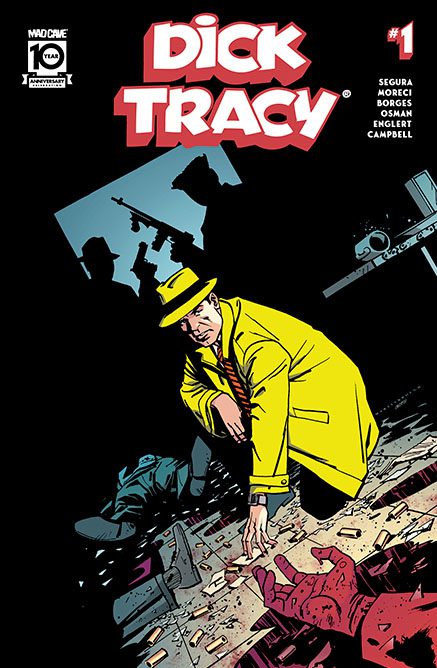
Credit: Mad Cave Studios
Summarizing the plot of Dick Tracy #1 is difficult to do without spoiling some of the excitement of reading the comic and encountering the Dick Tracy treats that are included within its pages. We shall try our best: The story opens with <redacted> having a secret meeting with a journalist, dishing the dirt in an attempt to clear his conscience. The rendezvous is broken up by <redacted> who <redacted>, and leaves chaos in his wake. This brings <redacted> into the picture who teams up with Dick Tracy to bust the case open wide.
Clawing at the origin story originally penned by Chester Gould in 1931, this new Dick Tracy comic combines the soap opera narrative style of Gould’s early stories with the outlandishness of his creative pinnacle in the 1940s, the era that influenced the 1990 movie. It is fast-paced and action-packed, with a surprising amount of plot development in the first issue. There are a lot of exciting and compelling moments that come with a post-Tarantino cinematic feel. This is a modern day crime story owing as much to John Wick as it does Ed Brubaker and Sean Phillips’ Criminal series. From the opening shootout to the closing reveal, this comic grabs hold of you and drags you along. This is how Junior must have felt in those early strips.
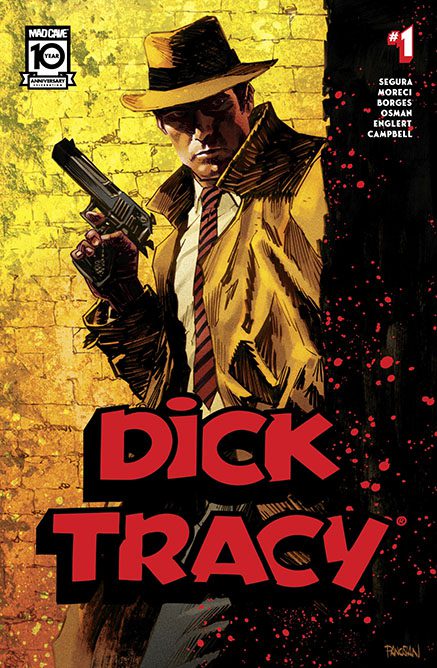
Credit: Mad Cave Studios
Alex Segura and Michael Moreci are on writing duties, crafting a tale that is both new and old; a postmodern pastiche of Gould’s creation and subsequent offspring. It is a modern take on the early stories with a heavy leaning towards the noir, pulpy aspect of the characters and stories. The violence inherent in the narrative might seem more excessive spread across these glorious pages, but it is only the modern comic book artistic style that creates this impression. Chester Gould’s stories were packed with cruel, harsh violence that, at times, is shocking even to a modern audience. Warren Beatty’s take opened with the bloody massacre of a rival gang all in front of a young child’s eyes. There is no holding back and, like a runaway tram careening down a busy street, the story stops for no-one.
One of the most exciting aspects of the narrative are the recognisable characters that make welcome appearances. With a host of villains and companions to draw from, it is the choices that the writers have made that are intriguing. There are obvious characters in there (you can’t have Superman without Lois Lane, or Batman without Alfred), so one or two of the appearances in Dick Tracy will come as no surprise. However, some of the other choices are brilliant and get the fan juices flowing—a turn of phrase I won’t be using again. Talking about them, even who they are, verges on spoiler territory and, if nothing more, ruins the surprise, so their involvement will have to be examined at a later date. Just be reassured that if you are a Dick Tracy fan, this story delivers.
The Brazilian artist Geraldo Borges is drawing this new interpretation of Dick Tracy and has instantly created the perfect aesthetic for the noir detective story. Comic books are different to comic strips; the layouts are obviously different, with much more space to use, but also the pacing and storytelling are different. With a daily strip, there is so much that has to be crammed into a few panels, catching up readers from previous episodes and moving the story forward; the reductive nature of the art form plays a much bigger part. With a monthly comic book, there is a bit more space to breathe, especially in today’s market where story arcs are told over numerous issues and the one and done comics of yesteryear have mostly disappeared.
With that said, Borges has still embraced the urgency and straight forward storytelling of the comic strip in his work. There are panels comprised of simple forms denoting the characters, and he is not afraid to use blacked out foregrounds that cut a large hole into the page. These moments draw the eye and shape the page. They remind the reader of the nature of the story being told but also recall the black and white newspaper strips that birthed this franchise.
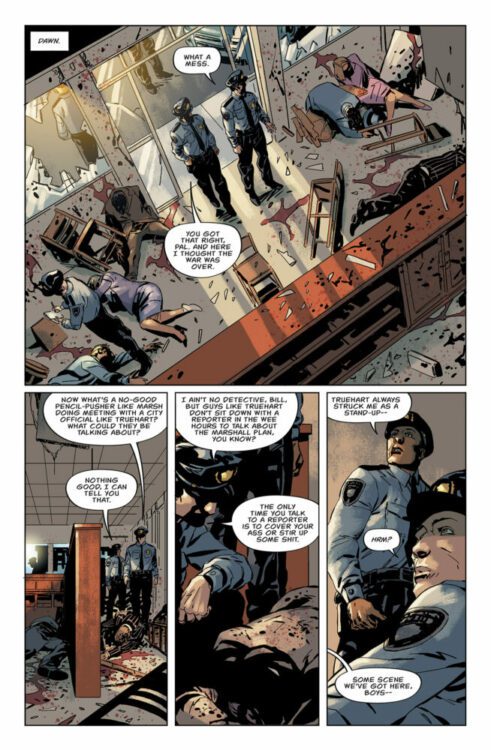
Credit: Mad Cave Studios
One of the defining qualities of Warren Beatty’s movie was the colourisation. Bright and bold, the movie went out of its way to capture a comic book colour scheme, turning its back on the realist aspects of cinema. Even though the movie gets a lot of negativity, that colourful aspect has become synonymous with Dick Tracy. This is something that colorist Mark Englert has clearly picked up on. The backgrounds reflect the mood of the scene and the costumes are garish and delightful. Tracy’s infamous yellow coat has not been dulled in the slightest. It blazes like a beacon on the page and, as a fan, I wouldn’t want it any other way.
The bright colours also serve a storytelling purpose, as they lead the reader through the page. Your eyes are drawn to the brightest colour, which is always the central character in that scene, and naturally follow that character across the page, from panel to panel. The focus remains constantly on the character that the writers want you to follow, with the extras almost becoming background. There is a reason why superheroes wear brightly coloured costumes, and this crime comic demonstrates that reason better than a lot of recent superhero comics.
You know you are in good hands when a speech balloon with two words in it can give you goosebumps. Letterer Jim Campbell’s recreation of the Dick Tracy title, which is used to announce the titular character’s first appearance, says everything you need to know about this comic. It calls back to the 90-year history of the character and the multiple media tie-ins, while also finding fresh, new ground to cover. Campbell is an expert at what he does, which is classic comic book lettering, and for the most part the speech drifts into the background. Visible but not noticeable. However, there are moments, especially with the sound effects, where the lettering takes center stage. There is one moment in particular, in the opening scene, that contains some astonishing lettering built into the fabric of the image. Again, it draws on the history of the character, referencing the opening sequence from the 1990 movie, but it is also new, a modern take on a classic idea. It’s just a shame that to talk about it too much would spoil the moment, spoil the excitement the reader will get from it.
And that is at the heart of this Dick Tracy comic: the excitement readers will get from this comes from the history of the character and the genre, and how the creators have lovingly used these elements to produce an homage to a great comic strip, but also all of the tie-in media that has followed since. Dick Tracy #1 does all these amazing things while also carving out its own modern story and style. It is both old and new.
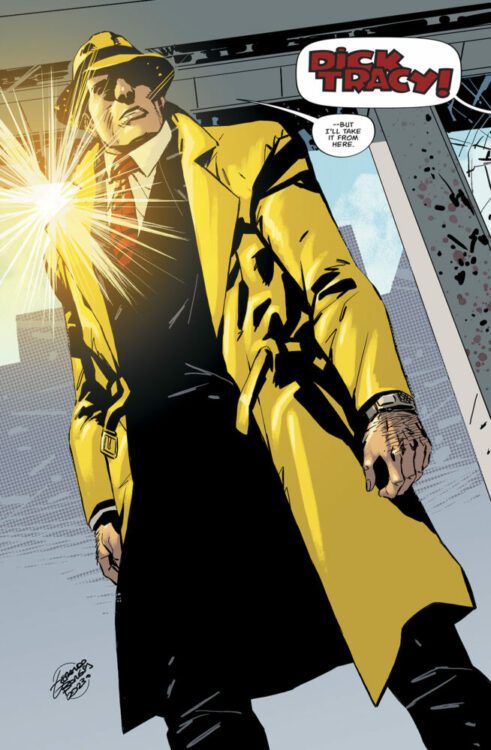
Credit: Mad Cave Studios
It has to be said that I am a fan of Dick Tracy. Reading this comic is an absolute dream. It is everything that I want from a modern version of the character told in a comic book format. Each of the creators captures elements of the characters’ history and brings it together to tell a story that is captivating, compelling, and packed with sweet, sweet Easter eggs. Plus one of my favourite characters is central to the plot. I clapped my hands with joy at the mere mention of his name. However, if you are not a Dick Tracy fan, you will just have to enjoy the superb artwork, the loving homage to noir narrative, and the complex character interactions. Because that’s the real beauty of this comic, it is first and foremost a work of entertainment that anyone can pick up and read. The character archetypes and plot mechanics are so much more than Dick Tracy related throwbacks, the comic embraces the entire pulp noir genre. It is a very modern comic, using elements of storytelling that any comic book reader will recognise and understand. This has definitely been created by people who have a passion for Dick Tracy but it is not aimed just at that small fandom. You need to know nothing of the character or his history to read this. You can simply pick it up and enjoy it straight out of the gate.
Hopefully, this comic will be a gateway for a host of new fans, who can become lost in the history of the character and its creator Chester Gould. And, fingers crossed, it will bring new eyes to the 1990 movie, a new generation who can seek it out and agree that it is the greatest comic book movie ever. (This is a hill I am willing to die on.)
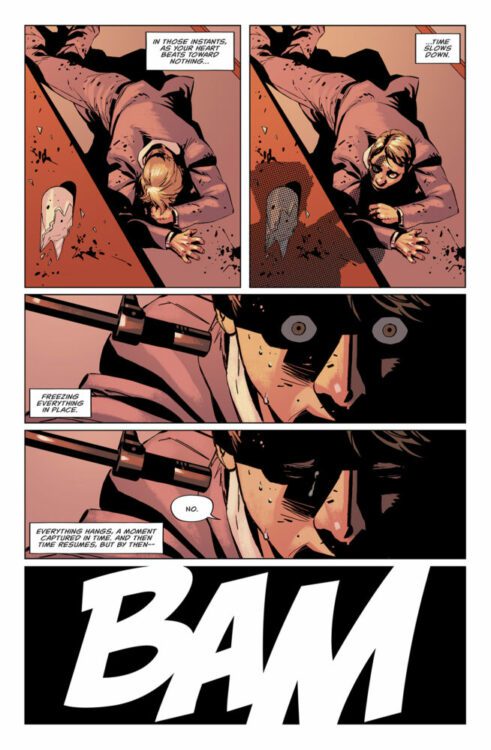
Credit: Mad Cave Studios
Dick Tracy #1 is published by Mad Cave Studios and goes on general release on April 24th.

